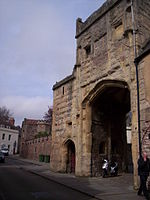Diocese of Bath and Wells
10th-century establishments in England909 establishmentsChristianity in Bath, SomersetDiocese of Bath and WellsDioceses established in the 10th century ... and 3 more
Dioceses of the Church of EnglandOrganisations based in SomersetReligion in Dorset

The Diocese of Bath and Wells is a diocese in the Church of England Province of Canterbury in England. The diocese covers the county of Somerset and a small area of Dorset. The Episcopal seat of the Bishop of Bath and Wells is located in the Cathedral Church of Saint Andrew in the city of Wells in Somerset.
Excerpt from the Wikipedia article Diocese of Bath and Wells (License: CC BY-SA 3.0, Authors, Images).Diocese of Bath and Wells
Cathedral Green, Wells
Geographical coordinates (GPS) Address Nearby Places Show on map
Geographical coordinates (GPS)
| Latitude | Longitude |
|---|---|
| N 51.210277777778 ° | E -2.6427777777778 ° |
Address
Wells Cathedral
Cathedral Green
BA5 2UE Wells
England, United Kingdom
Open on Google Maps










